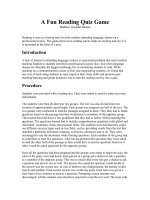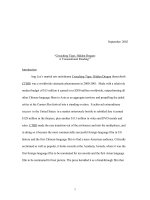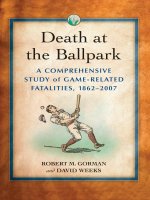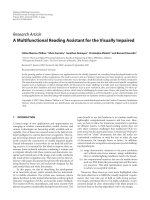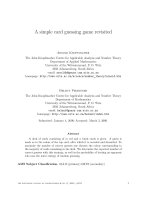A Fun Reading Quiz Game
Bạn đang xem bản rút gọn của tài liệu. Xem và tải ngay bản đầy đủ của tài liệu tại đây (57.68 KB, 2 trang )
A Fun Reading Quiz Game
Madhavi Gayathri Raman
Reading is seen as a boring task for most students attending language classes on a
professional course. This game shows how reading can be made an exciting activity if it is
presented in the form of a quiz.
Introduction
A lack of interest in attending language courses is a persistent problem that most teachers
teaching English to students enrolled in professional courses face. And when language
classes are attended, the biggest challenge lies in motivating students to read. While
teaching on a communications course to first year engineering students, we found that one
way of motivating students to read, improve their study skills and promote peer
teaching/learning and group dynamics was to turn the reading activity into a quiz.
Procedure
Students were provided with a reading text. They were asked to read the entire text once
individually.
The students were then divided into two groups. The text was also divided into two
sections of approximately equal length. Each group was assigned one half of the text. The
two groups were instructed to read the passages assigned to them. They then had to frame
questions based on the passage that they would pose to members of the opposite group. The
teacher then laid down a few guidelines that they had to follow while preparing the
questions. The questions framed had to include comprehension questions, both global and
inferential, vocabulary items and grammar items. The students were told that they could
use different exercise types such as true/false, yes/no, providing words from the text that
matched a particular dictionary meaning, synonyms, antonyms and so on. They were
encouraged to use the dictionary while framing questions. Each member of the group had
to contribute at least two questions. After having prepared the questions they were asked to
read the other half of the passage as they would have to answer questions based on it (they
would be asked questions by the opposite group).
Once all the questions had been prepared and the groups were ready to begin the quiz, the
rules of the game were laid down. Each person in a group got a chance to ask a question to
a member of the opposite group. This was to ensure that every one got a chance to ask a
question and answer one as well. The person who asked the question would decide if the
answer was the correct one. In case of doubt or any disagreement, the teacher would step in
and mediate. Each correct answer was worth one point. Each team was given a time limit
of two minutes to answer a question. Prompting a team member was discouraged. All the
students were therefore required to read the text well. The team with the maximum number
of points would be declared the winner.
Once the students began working on the specific texts assigned to them we found that:
• they engaged with the text with a degree of intensity and thoroughness that we had
not seen earlier.
• they used their dictionaries to look up meanings of new words. Entries with
multiple meanings were looked at more carefully and clarifications were sought
from the teacher about their use. They began to pay more attention to symbols
accompanying the entries like PHV, IDM. Usually, the students ignored the
information conveyed by these symbols.
• each member of the group participated actively in the preparation of questions.
Even those who were generally quiet in class took interest in the activity. Possible
questions were suggested and while some were accepted others were rejected on the
grounds that they were too easy or direct. At all times, the endeavor was to pose
challenging questions to members of the opposite group.
• one group subdivided itself into smaller groups and each group took up the
responsibility of preparing a set of questions for different exercise types. They then
got together and compiled the entire set of questions.
• group members ensured that the weaker members of their group had looked at some
of the more important points in the text carefully so that they wouldn’t lose points.
In fact, some very covert prompting did occur until members of the opposite group
objected! The point we would like to stress here is that everyone was involved in
the activity and more importantly the students themselves did the teaching/learning.
• due to the nature of the exercise, the students were relaxed. Since it was perceived
of as a game, anxiety levels were low and all were motivated to participate. It is in a
well-known fact that a learning situation that has a “low affective filter” (Krashen,
1987) reduces anxiety and makes learners more comfortable. This encourages them
to use language and learning becomes more effective (Littlewood, 1995).
Finally and most importantly, the students read a text entirely on their own without
realizing that they were performing a task that most of them disliked - READING.
Conclusion
This kind of activity is one way of motivating students to read and sustaining their interest
in reading. When reading becomes a game it takes away the monotony that they appear to
associate with the act of engaging with the printed page. Instead the game aspect comes to
the foreground. The student believes he is playing a game (of course some smart ones
realize what is actually happening!) and the teacher succeeds in getting him to read without
his getting bored.
As the students start reading more complex passages, the teacher can modify the rules of
the game to include more challenging exercise types. Groups can be asked to prepare
exercises for their classmates which can then be exchanged.


